Difference between revisions of "Shrunken leather - leather shrinkage"
| Line 50: | Line 50: | ||
| − | + | [[Chrome tanned]] leather shrinks later than [[Chrome tanned#Chrome-free leather - FOC = Free of Chrome|chrome-free]] leather, but then significantly stronger. [[Synthetic tanned]] leather starts shrinking at 75 degrees Celsius, but will not contract as strongly as chrome leather. | |
| − | A problem of [[Chrome tanned#Chrome-free leather - FOC = Free of Chrome|chrome-free (FOC)]] [[synthetic tanned]] leather is the sensitivity to moisture in the leather plus heat. Approx. 50% of all [[car leather]] is FOC. If a convertible comes into | + | A problem of [[Chrome tanned#Chrome-free leather - FOC = Free of Chrome|chrome-free (FOC)]] [[synthetic tanned]] leather is the sensitivity to moisture in the leather plus heat. Approx. 50% of all [[car leather]] is FOC. If a convertible comes into rain, a liquid runs out or a wet towel or a wet swim suit remains too long on the leather, moisture migrates through the [[finish]], the [[Leather seams|seam holes]] or the [[Perforated leather|perforation holes]]. If sun shines on such moistered leather, the matrix water (chemically bound in leather) starts boiling and the leather hardens and shrinks. |
| Line 62: | Line 62: | ||
<p> </p> | <p> </p> | ||
| − | The moisture of leather | + | The moisture of leather has an effect on the shrinkage temperature. Dry leather is more stable than wet leather. Since leather absorbs the surrounding air humidity, the parameter "moisture" must be considered in case of critical applications of leather. |
| − | + | ||
| − | + | ||
| Line 72: | Line 70: | ||
</p> | </p> | ||
<p align=center> | <p align=center> | ||
| − | '' | + | ''Rear upholstery, above area of a [[Vintage & Classic car leather|classic car]]. - Shrunken [[Leather dashboard|dashboard]] leather of the Peugeot 307CC.''<br></p> |
<p> </p> | <p> </p> | ||
| Line 80: | Line 78: | ||
</p> | </p> | ||
<p align=center> | <p align=center> | ||
| − | '' | + | ''Shrunken Headrest by sun. - Fire hole in [[leather furniture]] by fallen lamp.''<br></p> |
<p> </p> | <p> </p> | ||
| − | + | Even during the [[tanning leather|tanning process]], the temperature to which the leather is exposed must be constantly checked. [[Rawhide]] should not be exposed to more than 30 degrees Celsius, since its stability against temperature influences is still low. During the tanning process, a temperature range from 50 to 70 degrees Celsius is generally kept. Furthermore, the temperature is to be monitored during [[Drying leather|drying]], [[finish]] and [[Embossed leather|embossing]] of the leather. | |
| Line 95: | Line 93: | ||
</p> | </p> | ||
<p align=center> | <p align=center> | ||
| − | '' | + | ''The rear upholstery top of the [[car leather#BMW|BMW E30 convertible]] is particularly prone to heat damages.''<br></p> |
<p> </p> | <p> </p> | ||
| Line 103: | Line 101: | ||
</p> | </p> | ||
<p align=center> | <p align=center> | ||
| − | '' | + | ''Unexplained shrinkage of individual fields on the [[car leather|back seat]] of a volvo. - Left picture: Only rear surface seat. - Right picture: Cracked leather in the back upholstery.''<br></p> |
<p> </p> | <p> </p> | ||
| Line 111: | Line 109: | ||
</p> | </p> | ||
<p align=center> | <p align=center> | ||
| − | '' | + | ''Left: halogen lamp. - Right: Expired hot liquid. Pulling of folds to the shrunken area is typical.''<br></p> |
<p> </p> | <p> </p> | ||
| Line 119: | Line 117: | ||
</p> | </p> | ||
<p align=center> | <p align=center> | ||
| − | '' | + | ''In case of cloth, the house would have burnt. Heat damage in the leather cause by a lamp.''<br></p> |
<p> </p> | <p> </p> | ||
| − | == | + | == [[Leather dashboard|Dashboard leather]] - Pre-Shrunk Leather == |
| − | + | Automotive manufacturers and their suppliers are taking advantage of the shrinking behavior of leather to trim [[Leather dashboard|dashboards]]. In order to achieve shape stability and to ensure that the leather remains stable even under the practical conditions in the car (sunshine and possibly high humidity), the leather is sometimes "pre-shrunken". This so-called "heat setting" is carried out by exposing the leather to short-term temperatures of more than 100 degrees Celsius. Long enough to achieve a lasting shape, but also short enough to prevent the leather becoming unusable. | |
| Line 130: | Line 128: | ||
</p> | </p> | ||
<p align=center> | <p align=center> | ||
| − | '' | + | ''[[Leather dashboard|Dashboard]] completely covered with leather.''<br></p> |
<p> </p> | <p> </p> | ||
| − | + | The used adhesive also plays an important role. The adhesive must be stronger than the forces of shrinkage of the leather. This can prevent shrinkage damages. | |
| Line 144: | Line 142: | ||
</p> | </p> | ||
<p align=center> | <p align=center> | ||
| − | '' | + | ''Shrunken [[Leather dashboard|dashboard]] leathers of the Peugeot 307CC.''<br></p> |
<p> </p> | <p> </p> | ||
Revision as of 15:47, 12 February 2017
Contents
Shrinkage of leather caused by heat
Leather can shrink and harden by excessive heat. Typical is damaged car leather at the top along the rear bench, the headrests and on dashboards. Leather also hardens because it dries out with time (without leather care). The leather fibers stiffen and become brittle.
This process is accelerated by the fact that the collagen of the fibers then denatures with release of the water previously bound in them. Initially, small singulated thickenings are formed in the leather fibre struccture, which subsequently expand and solidify. The density of the leather increases, but its dimensions decrease. This hardening is extremely stable. Once shrunken leather is therefore irreparably damaged and can sometiems be softened a little with appropriate care products, but the loss of surface is permanent and can not be recovered.
For wet leathers, even little heat is sufficient to shrink it. Wet leather should never be allowed to dry in the sun or on a heater. The best temperature to dry leather is normal room temperature.
Video about the shrinkage of leather.
Welle oiled and greased leather will never shrink as quickly as poorly maintained leather. The tanning methode of the leather directly influences its shrinkability. Traditionally vegetable-tanned leather already begin to shrink at 70 degrees Celsius. This looks like a high temperature, but which is reached quickly, when a convertible with wet, dark leather seats is put into the sun for drying. The leather is then "cooked" and shrinks. Modern tanning processes, such as chrome tanning, raise the threshold of leather shrinkage so that such leather starts shrinking between 85 to 110 degrees Celsius.
| Condition/tanning methode | Shrinkage temperature |
|---|---|
| Rawhide | 60°C - 65°C (140 - 149 °F) |
| After pickling before tanning | 40°C - 60°C (104 - 140 °F) |
| Vegetable-tanned leather | 70°C - 80°C (158 - 176 °F) |
| Chrome tanned | 85°C - 100°C (185 - 212 °F) |
| Synthetic tanned | 75°C - 85°C (167 - 185 °F) |
| Chamois leather | 60°C - 70°C (104 - 158 °F) |
Chrome tanned leather shrinks later than chrome-free leather, but then significantly stronger. Synthetic tanned leather starts shrinking at 75 degrees Celsius, but will not contract as strongly as chrome leather.
A problem of chrome-free (FOC) synthetic tanned leather is the sensitivity to moisture in the leather plus heat. Approx. 50% of all car leather is FOC. If a convertible comes into rain, a liquid runs out or a wet towel or a wet swim suit remains too long on the leather, moisture migrates through the finish, the seam holes or the perforation holes. If sun shines on such moistered leather, the matrix water (chemically bound in leather) starts boiling and the leather hardens and shrinks.
Shrinkage of synthetic tanned car leather due to moisture in leather and the heat of the sun.
The moisture of leather has an effect on the shrinkage temperature. Dry leather is more stable than wet leather. Since leather absorbs the surrounding air humidity, the parameter "moisture" must be considered in case of critical applications of leather.
Rear upholstery, above area of a classic car. - Shrunken dashboard leather of the Peugeot 307CC.
Shrunken Headrest by sun. - Fire hole in leather furniture by fallen lamp.
Even during the tanning process, the temperature to which the leather is exposed must be constantly checked. Rawhide should not be exposed to more than 30 degrees Celsius, since its stability against temperature influences is still low. During the tanning process, a temperature range from 50 to 70 degrees Celsius is generally kept. Furthermore, the temperature is to be monitored during drying, finish and embossing of the leather.
The rear upholstery top of the BMW E30 convertible is particularly prone to heat damages.
Unexplained shrinkage of individual fields on the back seat of a volvo. - Left picture: Only rear surface seat. - Right picture: Cracked leather in the back upholstery.
Left: halogen lamp. - Right: Expired hot liquid. Pulling of folds to the shrunken area is typical.
In case of cloth, the house would have burnt. Heat damage in the leather cause by a lamp.
Dashboard leather - Pre-Shrunk Leather
Automotive manufacturers and their suppliers are taking advantage of the shrinking behavior of leather to trim dashboards. In order to achieve shape stability and to ensure that the leather remains stable even under the practical conditions in the car (sunshine and possibly high humidity), the leather is sometimes "pre-shrunken". This so-called "heat setting" is carried out by exposing the leather to short-term temperatures of more than 100 degrees Celsius. Long enough to achieve a lasting shape, but also short enough to prevent the leather becoming unusable.
Dashboard completely covered with leather.
The used adhesive also plays an important role. The adhesive must be stronger than the forces of shrinkage of the leather. This can prevent shrinkage damages.
Shrunken dashboard leathers of the Peugeot 307CC.
Shrinkage of leather in the tannery
Since leather is sold by surface, the tanner tries to get an as large as possible hide by the tanning process. However, leathers are sometimes deliberately shrunken, so that the leather becomes thicker and the grain pattern is reenforced. Such treatments are known in the case of cow neck leather and sheep leather. The company www.brocantique.de is a specialist for vegetal tanned sheep leather shrinkage. When shrinking sheep leather, it loses up to 20% of the surface and becomes thicker.
Shrunken sheep leather (www.brocantique.de).
Additional information
![]() -> COLOURLOCK - THE TREATMENT OF HARDENED LEATHER
-> COLOURLOCK - THE TREATMENT OF HARDENED LEATHER







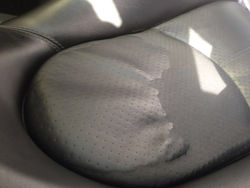
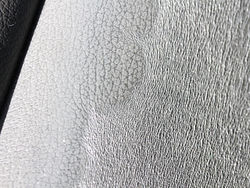
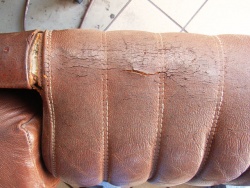
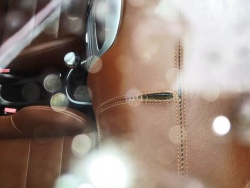
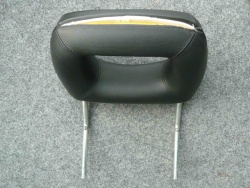
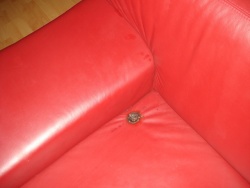
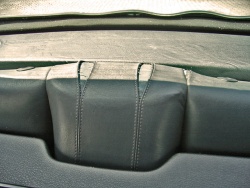
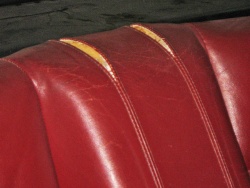
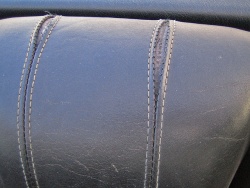
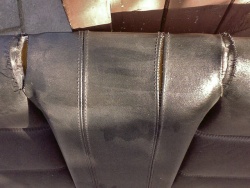
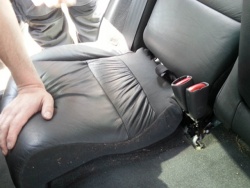
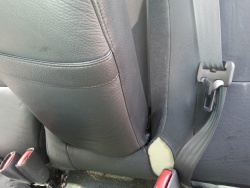
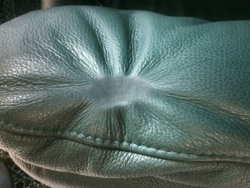
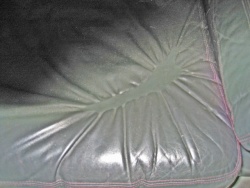
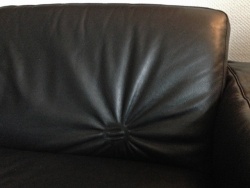
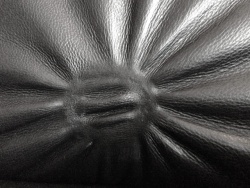
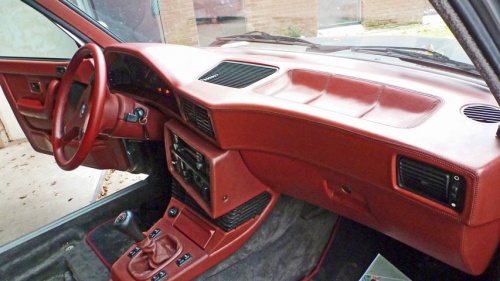
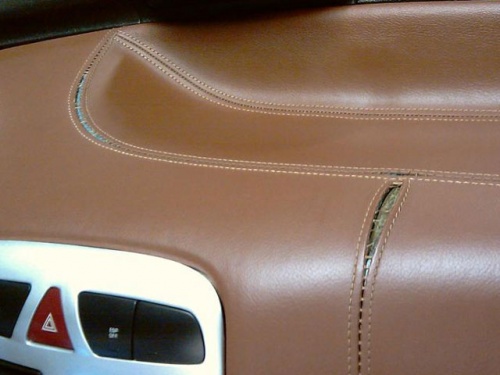
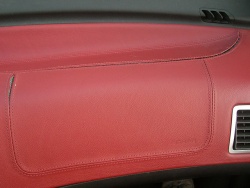
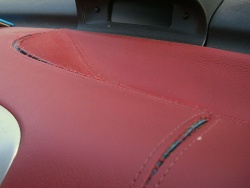
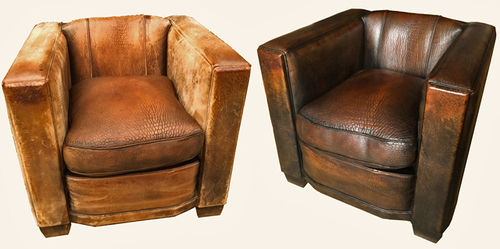

 a kotori web solution
a kotori web solution